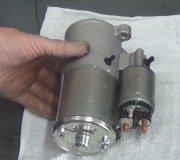I'm pretty sure those lugs are not part of the starter cables so they might have normal battery voltage on them while the starter suffers from low voltage. There has to be a high resistance connection someplace in those two cables. The thing to do is start at one of them, right at the battery, with one meter probe on the positive bolt, then follow that cable to the first accessible test point and put the other meter probe there. The meter will read 0 volts because both probes are in the same circuit. Next, when a helper cranks the engine, the high current will cause a voltage drop to occur across any abnormally high resistance. That resistance is way too small to measure, but you CAN measure the results of that resistance in the form of that voltage drop. Keep moving the probes of the meter to the next accessible point in the circuit. It won't take long to reach the large terminal on the starter. At each point, you're looking for a large increase in voltage during cranking. At a bare minimum, you must have 9.6 volts left at the starter after dropping some voltage along the way. The battery voltage will be drawn down a few volts too, but you must still be left with at least 9.6 at the starter. Let's guess the battery is drawn down to 11.0 volts during cranking. That's a typical value. Regardless where you measured 7 volts earlier, it's safe to assume you have that much or less at the starter. That means you're looking for a drop of 4.0 volts in total across all of the connections and cables in the starter circuit. It is acceptable to find 0.2 volts drop across any one connection. You can disregard those, but somewhere you're going to find a big voltage of a couple of volts. That's the connection that nust be cleaned up.
I'm going on the assumption there is a connection problem based on the stuff you said was already replaced. I can't read back far enough to double-check, but as I recall, you said the cables were already replaced. Do I remember correctly? If so, are they nice big fat cables at least as fat as the origineal ones?
Caradiodoc
Friday, June 18th, 2010 AT 7:15 PM



